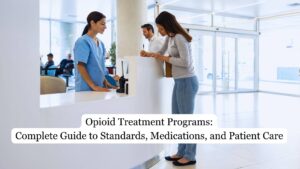Opioid use disorder remains one of the most serious public health challenges in the United States, with millions struggling to overcome dependence. Effective addiction treatment often includes the use of medication to support recovery. Two widely recognized options are Suboxone and Vivitrol, both approved by the Food and Drug Administration (FDA).
This article explains the differences, benefits, and considerations of these two medicines, helping individuals make informed decisions about their recovery process.
Understanding Suboxone
This prescription drug combines buprenorphine and naloxone, working together to ease withdrawal symptoms and reduce cravings. It lowers the risk of misuse by binding itself to receptors in the brain, producing limited effects compared to other opioids. This stabilization allows individuals to focus on counseling, behavioral therapies, and long-term recovery goals.
The medication can ease the healing process by reducing uncomfortable withdrawal symptoms without creating a strong euphoric effect. It is taken orally, usually as a film or tablet. People who use Suboxone under medical supervision may find it easier to remain in a treatment program, especially in the early stages of detox when cravings are strongest.
Understanding Vivitrol
This prescription injection contains naltrexone, an opioid antagonist. It works by preventing the brain from responding to opioids, which means that if someone uses these substances while on it, they will not feel the usual effects. It is also FDA-approved for the treatment of alcohol use disorder, making it a valuable option for individuals managing both alcohol and drug dependence. The injection is administered once a month, offering consistency and reducing the need for daily medication, and addiction treatment with Vivitrol can be paired with therapy for a more complete plan.
However, patients must be fully detoxed before starting use, as taking it too soon can trigger severe withdrawal symptoms. Careful planning with a healthcare provider is essential before beginning. Within a broader medication-assisted approach, this option is often paired with counseling and behavioral therapy to create a well-rounded recovery plan.
Comparing Suboxone and Vivitrol
When comparing these two medications, the main differences lie in how they affect the brain. A partial agonist eases withdrawal symptoms and cravings, while an antagonist blocks receptors entirely, preventing relapse by removing the rewarding effects of opioids. Both are effective, but the right choice depends on an individual’s unique circumstances, medical history, and recovery goals.
Another factor is accessibility. Suboxone can be prescribed in an outpatient setting and taken at home, offering flexibility. Vivitrol requires a clinic visit each month for the injection, which can provide accountability but may be less convenient. Cost, insurance coverage, and personal preference also influence the decision.

Risks and Side Effects
As with any medication for substance use disorders, both options can cause side effects. Suboxone may cause headache, nausea, constipation, or mild sedation. Despite these effects, it is considered safe when taken as prescribed. Because it contains naloxone, it also discourages misuse. Vivitrol can cause injection-site reactions, including pain, swelling, or irritation. More serious issues may include liver problems or severe allergic reactions.
Since patients must be opioid-free before starting, those with severe dependence may struggle with detox without additional medical support. Even so, Vivitrol is considered a safe and effective medication when prescribed appropriately, and it remains a valuable tool to prevent relapse and support long-term recovery.
Role in Comprehensive Addiction Treatment
Comprehensive care that includes counseling, behavioral therapy, and mental health services greatly improves outcomes. The Substance Abuse and Mental Health Services Administration and the National Institute on Drug Abuse emphasize that combining medication with therapy offers the strongest chance of lasting results and highlight the benefits of medication-assisted treatment in supporting long-term stability. This integrated approach not only helps people manage cravings and withdrawal but also addresses co-occurring challenges such as stress and mental health concerns.
Patients may also consider other options like methadone treatment. While methadone has been in use for decades, newer approaches such as Suboxone and Vivitrol have broadened the range of safe and effective tools available for those working toward healthier lives.
Final Thoughts from Raise the Bottom
The choice between Suboxone and Vivitrol depends on individual needs, medical history, and treatment goals. One helps ease withdrawal symptoms and cravings through controlled activation of brain receptors, while the other blocks the effects of opioids and alcohol entirely, reducing the chance of relapse. Both play vital roles in addiction treatment when paired with counseling and mental health services.
At Raise the Bottom, we understand that addressing opioid and alcohol use disorders requires a tailored approach. Our opioid addiction treatment programs in Idaho integrate evidence-based medication with therapy to strengthen the healing process and give individuals the tools to move forward with confidence.






